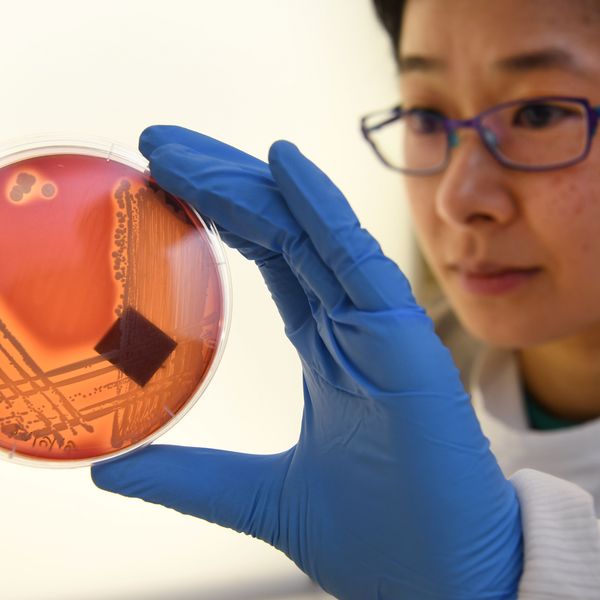Notorious Insecticides Found in Half of Sampled Streams in US
'Neonics' have been linked to decline in bee populations
A class of insecticides linked to the decline of bees has more found in more than half of the streams in the United States where samples were taken, new research has found.
Researchers with the U.S. Geological Survey (USGS) say it is the first national-scale study of the presence of neonicotinoids, or "neonics," in urban and agricultural land use settings across the nation.
Neonics can be used as a seed coating or foliar spray, and they are widely used, despite a body of evidence calling them a threat to global biodiversity and linking them to lethal and sub-lethal harm to bees.
The USGS reserachers detected at least one of six neonics in 63 percent of the 48 streams they sampled.
"In the study, neonicotinoids occurred throughout the year in urban streams while pulses of neonicotinoids were typical in agricultural streams during crop planting season," USGS research chemist Michelle Hladik, the report's lead author, said in a press statement.
A USGS study published last year focusing on just Midwest waterways detected neonics in all the 9 rivers and streams sampled, prompting Emily Marquez, PhD, staff scientist at Pesticide Action Network, to say, "The fact that neonics are pervasively contaminating surface waters should be a wake-up call for state and federal regulators, that must move more quickly to reduce and restrict use on farm fields."
The White House's Pollinator Health Task Force unveiled its strategy for improving pollinator health last year, and Mike Focazio, program coordinator for the USGS Toxic Substances Hydrology Program, said the new USGS "research will support the overall goals of the Strategy, by helping to understand whether these water-borne pesticides, particularly at the low levels shown in this study, pose a risk for pollinators."
Environmental groups have denounced the Strategy's goals for not going far enough to save bees as it fails to restrict the use of neonics.
An Urgent Message From Our Co-Founder
Dear Common Dreams reader, The U.S. is on a fast track to authoritarianism like nothing I've ever seen. Meanwhile, corporate news outlets are utterly capitulating to Trump, twisting their coverage to avoid drawing his ire while lining up to stuff cash in his pockets. That's why I believe that Common Dreams is doing the best and most consequential reporting that we've ever done. Our small but mighty team is a progressive reporting powerhouse, covering the news every day that the corporate media never will. Our mission has always been simple: To inform. To inspire. And to ignite change for the common good. Now here's the key piece that I want all our readers to understand: None of this would be possible without your financial support. That's not just some fundraising cliche. It's the absolute and literal truth. We don't accept corporate advertising and never will. We don't have a paywall because we don't think people should be blocked from critical news based on their ability to pay. Everything we do is funded by the donations of readers like you. Will you donate now to help power the nonprofit, independent reporting of Common Dreams? Thank you for being a vital member of our community. Together, we can keep independent journalism alive when it’s needed most. - Craig Brown, Co-founder |
A class of insecticides linked to the decline of bees has more found in more than half of the streams in the United States where samples were taken, new research has found.
Researchers with the U.S. Geological Survey (USGS) say it is the first national-scale study of the presence of neonicotinoids, or "neonics," in urban and agricultural land use settings across the nation.
Neonics can be used as a seed coating or foliar spray, and they are widely used, despite a body of evidence calling them a threat to global biodiversity and linking them to lethal and sub-lethal harm to bees.
The USGS reserachers detected at least one of six neonics in 63 percent of the 48 streams they sampled.
"In the study, neonicotinoids occurred throughout the year in urban streams while pulses of neonicotinoids were typical in agricultural streams during crop planting season," USGS research chemist Michelle Hladik, the report's lead author, said in a press statement.
A USGS study published last year focusing on just Midwest waterways detected neonics in all the 9 rivers and streams sampled, prompting Emily Marquez, PhD, staff scientist at Pesticide Action Network, to say, "The fact that neonics are pervasively contaminating surface waters should be a wake-up call for state and federal regulators, that must move more quickly to reduce and restrict use on farm fields."
The White House's Pollinator Health Task Force unveiled its strategy for improving pollinator health last year, and Mike Focazio, program coordinator for the USGS Toxic Substances Hydrology Program, said the new USGS "research will support the overall goals of the Strategy, by helping to understand whether these water-borne pesticides, particularly at the low levels shown in this study, pose a risk for pollinators."
Environmental groups have denounced the Strategy's goals for not going far enough to save bees as it fails to restrict the use of neonics.
A class of insecticides linked to the decline of bees has more found in more than half of the streams in the United States where samples were taken, new research has found.
Researchers with the U.S. Geological Survey (USGS) say it is the first national-scale study of the presence of neonicotinoids, or "neonics," in urban and agricultural land use settings across the nation.
Neonics can be used as a seed coating or foliar spray, and they are widely used, despite a body of evidence calling them a threat to global biodiversity and linking them to lethal and sub-lethal harm to bees.
The USGS reserachers detected at least one of six neonics in 63 percent of the 48 streams they sampled.
"In the study, neonicotinoids occurred throughout the year in urban streams while pulses of neonicotinoids were typical in agricultural streams during crop planting season," USGS research chemist Michelle Hladik, the report's lead author, said in a press statement.
A USGS study published last year focusing on just Midwest waterways detected neonics in all the 9 rivers and streams sampled, prompting Emily Marquez, PhD, staff scientist at Pesticide Action Network, to say, "The fact that neonics are pervasively contaminating surface waters should be a wake-up call for state and federal regulators, that must move more quickly to reduce and restrict use on farm fields."
The White House's Pollinator Health Task Force unveiled its strategy for improving pollinator health last year, and Mike Focazio, program coordinator for the USGS Toxic Substances Hydrology Program, said the new USGS "research will support the overall goals of the Strategy, by helping to understand whether these water-borne pesticides, particularly at the low levels shown in this study, pose a risk for pollinators."
Environmental groups have denounced the Strategy's goals for not going far enough to save bees as it fails to restrict the use of neonics.


